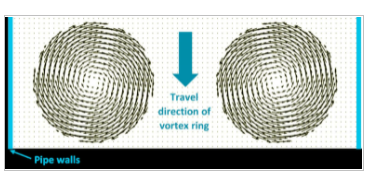Vortex rings could cut water consumption in process industry

Vortex rings, a naturally-occurring phenomenon seen in fluids, could be harnessed to reduce water consumption in process industry cleaning systems says R&D consultancy Sagentia Innovation. With water preservation now a major sustainability concern, the consultancy has been investigating ways to address water consumption in clean-in-place (CIP) systems. Initial analysis identified the rinse phase following wash cycles as an opportunity to innovate, and it was determined that vortex rings hold high potential for certain applications. A vortex ring is a torus (‘doughnut-shaped’) fluid structure which travels forward by rotating within itself. From a physics perspective, this is because the velocity field is smaller towards the centre of the torus and greater towards the edge. Conversely, the flow of liquid through a pipe is typically faster in the centre and slower towards the walls. This is the opposite of what is required to draw cleaning product residue into the bulk flow and out of the system. So, CIP systems require high flow speeds to induce turbulence to improve mixing, which results in large quantities of water being used. A team of scientists and engineers at Sagentia Innovation investigated how vortex rings might enable equivalent rinsing action at lower overall speeds, ultimately reducing total water consumption. Coco Day, Science and Technology Consultant, explains that the team modelled vortex ring behaviour in a pipe on a scale used in the food and beverage industry. “Our hypothesis was that a vortex ring travelling down a pipe would induce mixing, entraining fluid from the near-wall region into the central part of the tube. If true, a simple vortex generation device, such as a piston, could be very effective in reducing CIP water consumption without compromising rinse phase performance. “However, while recent academic research characterises the form and motion of vortex rings, very little work has been done on their behaviour in pipes, and even less in pipes which contain a background flow. Our findings to date suggest that vortex rings can indeed survive, and in fact move further, in a laminar background flow. This finding is very encouraging, and we are now exploring vortex rings’ behaviour within faster-flowing turbulent media. Vortex rings could represent a rich new seam of innovation and product development for CIP systems.”
1.The news above mentioned with detailed source are from internet.We are trying our best to assure they are accurate ,timely and safe so as to let bearing users and sellers read more related info.However, it doesn't mean we agree with any point of view referred in above contents and we are not responsible for the authenticity. If you want to publish the news,please note the source and you will be legally responsible for the news published.
2.All news edited and translated by us are specially noted the source"CBCC".
3.For investors,please be cautious for all news.We don't bear any damage brought by late and inaccurate news.
4.If the news we published involves copyright of yours,just let us know.
BRIEF INTRODUCTION
Cnbearing is the No.1 bearing inquiry system and information service in China, dedicated to helping all bearing users and sellers throughout the world.
Cnbearing is supported by China National Bearing Industry Association, whose operation online is charged by China Bearing Unisun Tech. Co., Ltd.
China Bearing Unisun Tech. Co., Ltd owns all the rights. Since 2000, over 3,000 companies have been registered and enjoyed the company' s complete skillful service, which ranking many aspects in bearing industry at home and abroad with the most authority practical devices in China.





